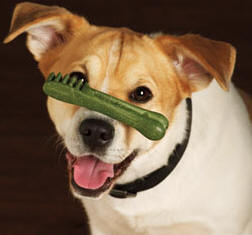|
|
Dog Behavior Library
|
Destructive
Chewing
What
Is It?
Chewing on any inappropriate
or forbidden item such as shoes,
plants, furniture, toys, etc.
What
Causes It?
Many dogs destructively chew
out of boredom or stress (anxiety).
Chewing is a natural dog
behavior. Dogs can be redirected to
appropriate chewing of their own
items.
Who
Does It?
Some breeds have tendency to
chew more than others.
All puppies chew to some extent.
When
Does It Happen?
Puppies explore the world more,
and teething occurs between
four and six months. If chewing
occurs due to separation anxiety,
it usually takes place shortly
after the owner leaves.
Where Does It Happen?
Any dog will tend to return to
the same items or spot that
attracted them in the first
place.
|
To
reduce destructive chewing,
increase daily exercise,
training, supervision, and
indoor companionship. |
How
Can I Stop It?.jpg)
First, remove or reduce the
basic cause, then redirect the
dog to acceptable chewing.
-
Don't allow any
unsupervised access to
unacceptable chew items,
until chew trained.
Teach "Contented
Confinement" by
providing chews while
confined. Praise and
encourage chewing on
approved items.
When not confined,
initially follow dog and
interrupt and scold
inappropriate chewing.
If not accepting chews,
begin with very edible
(Greenies), then work up
the hardness scale to
Veggie Chews, Pig Ears,
Rawhide, and finally
Nylon. Monitor teeth for
clean
 surfaces, or
unusual wear.
-
Make dog's bone more desirable:
·
Identify his favorite types.
·
Apply peanut butter, or
liverwurst, to the bone.
Hollow bones work well.
· Praise
any interest the dog shows
in chew toy or bone.
· Place
it in his mouth and praise
him.
· Require
the dog to have his bone in
his mouth before you will
greet him.
Commercial taste
deterrents are also available
to make objects undesirable.
-
Here are some
SAFETY TIPS from
IAMS for you and your
dog to keep chew treats and
chew toys a safe and healthy
activity:
Tip #1:
There is some risk of
digestive tract obstruction
with ANY type of chew treat
or chew toy. Safety is
always a concern when a dog
chews. Many natural objects
such as sticks, rocks, bones
and other assorted objects
can get stuck in their
throats or intestines. As a
dog owner, you are
ultimately responsible for
monitoring your dog closely
to make certain that the
chew treat is chewed well.
Tip
#2: Chew
treats and chew toys should
be sized appropriately for
your dog. In other words,
your dog should not be given
a chew treat/toy that could
be swallowed whole. Packages
should indicate the
appropriate size dog for the
chew treat/toy. If in doubt,
ask your retailer or contact
the manufacturer.
Tip
#3: Observe
your dog playing with the
chew toy or eating the chew
treat. With the chew treat
your dog should gnaw on it
with the side teeth and
swallow pieces of the edible
chew. Since dogs don't have
the same crushing molars
that humans have, they will
slice off pieces with the
side teeth. Many dogs will
hold the treat in their paws
or simply move it from side
to side in their mouth as
they chew off small pieces.
Tip
#4: If your
dog has a history of
ingesting foreign objects
such as rocks, sticks or
toys, you may not want to
give him or her chew
treats/toys at all. Try
edible biscuits instead.
Tip
#5: Watch
for choking, excessive
drooling, vomiting, poor
appetite, lethargy or
abnormal bowel movements. If
you notice any of these
signs, seek veterinary care
sooner rather than later!
Tip
#6: When in
doubt about what is
appropriate for your dog,
contact your veterinarian.
He or she can offer
professional advice.
|
|
|